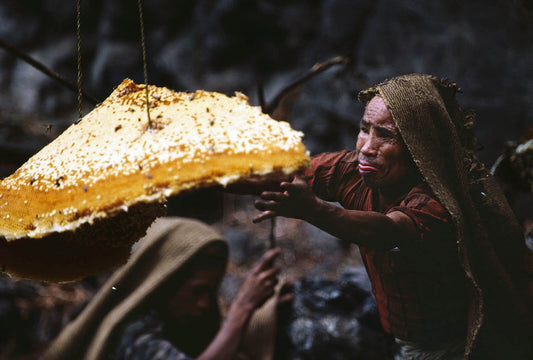The History of Mad Honey: From Ancient Rituals to Modern Uses
Share

Mad Honey is known for its potent, psychoactive effects and medicinal properties.
Mad Honey, a rare and intriguing substance harvested in the rugged mountains of Nepal, has a history as fascinating as its effects. With origins that trace back thousands of years, mad honey has played a crucial role in both spiritual rituals and ancient warfare. But what exactly is mad honey, and how has it been used over the centuries?
What is Mad Honey?
Mad honey is produced by the giant Himalayan bee (Apis dorsata laboriosa), which feeds on the nectar of certain rhododendron flowers. These flowers contain grayanotoxins, which give mad honey its intoxicating and hallucinogenic effects when consumed in larger amounts. This honey is not only a sweetener but a substance with cultural, medicinal, and ritual significance.
For centuries, mad honey has been a sacred substance used in religious and spiritual ceremonies.
Ancient Rituals and Spiritual Practices
In the regions where mad honey is harvested, particularly among the Gurung tribes of Nepal, it has been used for centuries in spiritual ceremonies. Honey hunters risk their lives scaling steep cliffs to collect this honey from hives, honoring age-old traditions that have been passed down through generations.
Mad honey has long been associated with shamanic rituals, used to induce trance-like states and connect with higher realms of consciousness. The psychoactive properties of mad honey were believed to offer a gateway to the spirit world, helping shamans and spiritual leaders commune with their gods.
Mad Honey in Warfare
Mad honey has been used as a weapon, most notably against Roman soldiers in 67 BCE.
Mad honey has a notorious history in warfare, especially during the era of the Roman Empire. According to historical accounts, in 67 BCE, Roman soldiers were poisoned with mad honey during their campaign in what is now modern-day Turkey. Local tribes placed pots of mad honey in the path of the advancing Roman army. After consuming the honey, the soldiers became disoriented and incapacitated, leading to a decisive victory for the locals.
This incident is one of the earliest documented cases of mad honey poisoning, illustrating its use as both a weapon and a tool for manipulating enemies.
Modern Uses of Mad Honey
Today, mad honey is prized for its unique properties, both in terms of its taste and its effects. It is still collected in remote parts of Nepal and Turkey, where it is sold as a rare delicacy with reputed medicinal benefits. Some of the modern uses of mad honey include:
- Pain relief for conditions like arthritis and nerve pain.
- Improving sexual performance due to its aphrodisiac effects.
- Boosting immunity and overall vitality.
Mad Honey has become a highly sought-after delicacy, known for its medicinal uses and rare intoxicating effects.
However, its use must be approached with caution. Consuming too much mad honey can lead to symptoms like nausea, vomiting, and even heart issues. Moderation is key to enjoying its benefits without risking the dangers of mad honey poisoning.
The Legacy of Mad Honey
From ancient rituals to modern medicine, mad honey remains one of nature’s most fascinating and potent substances. Its role in spiritual practices, warfare, and now as a medicinal remedy ensures that this Himalayan treasure will continue to captivate people for generations to come.
Whether you're looking for an alternative treatment or simply intrigued by its history, mad honey offers a unique experience like no other. But remember, use it responsibly to enjoy all the benefits this remarkable honey has to offer.


